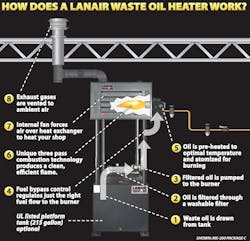Because waste oil furnaces operate on used motor oil, transmission fluid and other petroleum products, they generate solid a return-on-investment by generating energy in the form of heat, plus help protect the environment by eliminating their disposal.
The key is to select the appropriate unit or units for the particular facility, and that begins with how large a building is, says Tom Francois, national sales manager for Lanair Products (www.lanair.com), the number one manufacturer of used oil and waste oil fired heaters. It offers heaters in BTU capacities to heat from 3,500 to 10,000 square feet.
Another consideration is deciding upon a warm air heater and a boiler that burns waste oil.
"Waste oil heaters are ideal for customers with buildings that need to maintain a consistent, comfortable temperature or recover lost heat rapidly from frequently opening and closing bay doors in the winter," he says.
"Waste oil boilers are also a comfort product, but unlike waste oil heaters. they are not designed with the goal of heating an open area. Instead, boilers are often used for more direct heating applications like radiant floors and baseboards, melting snow and ice and even car washes.
"They are designed to be modular and allow the creation of larger systems by simply adding more boilers as needed."
Francois notes that some customers do not produce enough waste oil to heat their building through an entire cold season, but still prefer to use waste oil heaters over other alternative heat sources. In this case, other approved heating oils, such as No. 2 heating oil, can be combined or used to completely replace waste oil as a fuel source.
Waste oil heaters burn used motor oil, synthetic motor oils, transmission fluids, hydraulic fluids, diesel fuel and fuel oil, and they can all be mixed together, he adds.
About the Author

